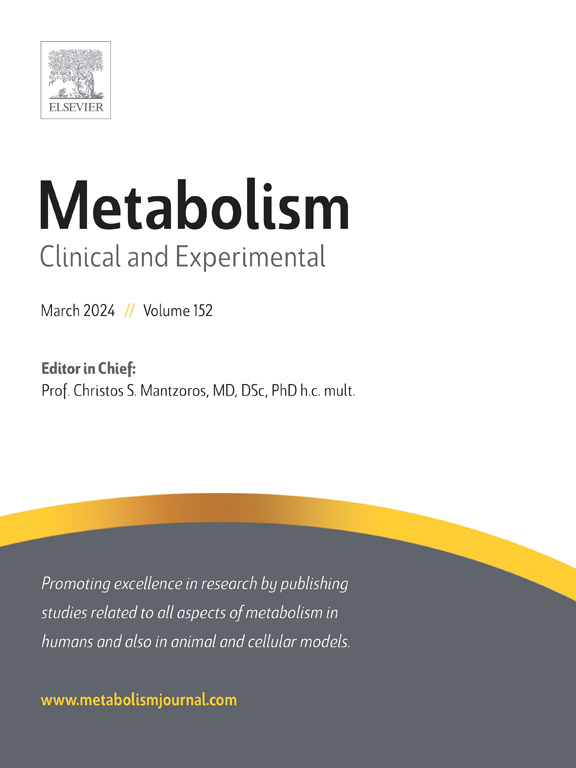降糖药物靶点对心、肾、肝代谢健康的因果效应及代谢介质的综合评价
IF 10.8
1区 医学
Q1 ENDOCRINOLOGY & METABOLISM
引用次数: 0
摘要
目的:探讨降糖药物与心肾肝代谢(CRLM)健康的关系。方法:采用双样本孟德尔随机化(MR)评估7类降糖药物与CRLM健康结局之间的因果关系。药物暴露的遗传代理被确定为药物靶基因中的顺式作用单核苷酸多态性,与基因表达水平和糖化血红蛋白(HbA1c)或体重指数(BMI)相关。验证包括共定位和联动不平衡分析。采用两步MR策略来探索潜在的代谢物介质。结果:磺脲类药物与降低心力衰竭(HF)风险相关(降糖药物靶标干扰每标准差变化的比值比[OR] = 0.38,相当于降低1个单位的HbA1c, P = 2.46E-04),但与升高天冬氨酸转转酶水平相关(OR = 1.39,P = 9.50E-07)。Sodium-glucose cotransporter-2抑制剂降低急性心肌梗死(AMI)的风险(或 = 0.37,P = 1.36 e-05),静脉血栓栓塞(VTE)(或 = 0.48,P = 1.89 e-04),微量白蛋白尿(MA)(或 = 0.49,P = 1.65 e-06),并增加肾小球滤过率(eGFR)(或 = 1.04,P = 2.98 e-05)。他们还显示一个潜在的保护作用与一般肝脏疾病(或 = 0.41,P = 4.79 e-04),代谢脂肪变性dysfunction-associated肝病(MASLD)(或 = 0.25,P = 0.008),和代谢综合症(大都会)(或 = 0.63,P = 5.40 e-04)。噻唑烷二酮类)的风险降低AMI(或 = 0.44,P = 4.31 38吗),高血压(HT)(或 = 0.60,P = 1.40 e-43), MASLD(或 = 0.53,P = 5.61 e-05),和大都会(或 = 0.66,P = 1.00 e-20),但增加静脉血栓栓塞的风险(或 = 1.40,P = 2.53 e-07),心房纤颤(或 = 1.61,P = 1.43 e-09),和酒精性肝病(或 = 3.00,P = 6.56 e-11)。TZDs对eGFR (OR = 0.97,P = 4.68E-05)和血尿素氮水平升高(OR = 1.03,P = 2.52E-09)也有负面影响。胰高血糖素样肽-1受体激动剂显示出对慢性肾脏疾病的显著益处,其驱动因素是血糖水平(OR = 0.11,P = 0.016)和BMI (OR = 0.20,P = 0.012)的降低,以及BMI降低可能带来的心脏代谢益处。已经确定了代谢物的一些介导作用(例如,SGLT2抑制剂通过异亮氨酸介导对MA的影响,TZDs通过脂质代谢物介导对MASLD的影响)。结论:降糖药物对CRLM健康有显著且异质性的影响,需要个性化治疗,并进一步研究其机制和对CRLM结果的长期影响。本文章由计算机程序翻译,如有差异,请以英文原文为准。
Comprehensive assessment of the causal effects and metabolite mediators of glucose-lowering drug targets on cardio-renal-liver-metabolic health
Aims
To investigate the relationship between glucose-lowering medications and cardio-renal-liver-metabolic (CRLM) health.
Methods
Two-sample Mendelian randomization (MR) was applied to assess the causal relationships between seven classes of glucose-lowering drugs and CRLM health outcomes. Genetic proxies for drug exposure were identified as cis-acting single nucleotide polymorphisms in the drug target genes, linked to both gene expression levels and glycosylated hemoglobin (HbA1c) or body mass index (BMI). Validation included colocalization and linkage disequilibrium analyses. A two-step MR strategy was employed to explore potential metabolite mediators.
Results
Sulfonylureas were associated with a reduced heart failure (HF) risk (odds ratio [OR] = 0.38 per standard deviation change in glucose-lowering drug target perturbation equivalent to 1 unit of HbA1c lowering, P = 2.46E-04) but increased aspartate aminotransferase levels (OR = 1.39, P = 9.50E-07). Sodium-glucose cotransporter-2 inhibitors reduced the risk of acute myocardial infarction (AMI) (OR = 0.37, P = 1.36E-05), venous thromboembolism (VTE) (OR = 0.48, P = 1.89E-04), microalbuminuria (MA) (OR = 0.49, P = 1.65E-06), and increased estimated glomerular filtration rate (eGFR) (OR = 1.04, P = 2.98E-05). They also showed a potential protective effect against general liver disorders (OR = 0.41, P = 4.79E-04), metabolic dysfunction-associated steatotic liver disease (MASLD) (OR = 0.25, P = 0.008), and metabolic syndrome (MetS) (OR = 0.63, P = 5.40E-04). Thiazolidinediones (TZDs) reduced the risk of AMI (OR = 0.44, P = 4.31E-38), hypertension (HT) (OR = 0.60, P = 1.40E-43), MASLD (OR = 0.53, P = 5.61E-05), and MetS (OR = 0.66, P = 1.00E-20) but increased the risk of VTE (OR = 1.40, P = 2.53E-07), atrial fibrillation (OR = 1.61, P = 1.43E-09), and alcoholic liver disease (OR = 3.00, P = 6.56E-11). TZDs also negatively affected eGFR (OR = 0.97, P = 4.68E-05) and increased blood urea nitrogen levels (OR = 1.03, P = 2.52E-09). Glucagon-like peptide-1 receptor agonists demonstrated significant benefits for chronic kidney disease, driven by reductions in both glucose levels (OR = 0.11, P = 0.016) and BMI (OR = 0.20, P = 0.012), with potential cardiometabolic benefits from BMI reduction. Some mediating roles of metabolites have been identified (e.g., SGLT2 inhibitors mediate effects on MA via isoleucine and TZDs mediate effects on MASLD through lipid metabolites).
Conclusions
Glucose-lowering medications exert significant and heterogeneous effects on CRLM health, highlighting the need for personalized treatments and further investigations into their mechanisms and long-term impacts on CRLM outcomes.
求助全文
通过发布文献求助,成功后即可免费获取论文全文。
去求助
来源期刊

Metabolism: clinical and experimental
医学-内分泌学与代谢
CiteScore
18.90
自引率
3.10%
发文量
310
审稿时长
16 days
期刊介绍:
Metabolism upholds research excellence by disseminating high-quality original research, reviews, editorials, and commentaries covering all facets of human metabolism.
Consideration for publication in Metabolism extends to studies in humans, animal, and cellular models, with a particular emphasis on work demonstrating strong translational potential.
The journal addresses a range of topics, including:
- Energy Expenditure and Obesity
- Metabolic Syndrome, Prediabetes, and Diabetes
- Nutrition, Exercise, and the Environment
- Genetics and Genomics, Proteomics, and Metabolomics
- Carbohydrate, Lipid, and Protein Metabolism
- Endocrinology and Hypertension
- Mineral and Bone Metabolism
- Cardiovascular Diseases and Malignancies
- Inflammation in metabolism and immunometabolism
 求助内容:
求助内容: 应助结果提醒方式:
应助结果提醒方式:


